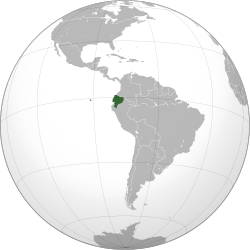Ecuador: Shiwiar Nation Stands Up
By Luis Ángel Saavedra
Few Ecuadorians, even the indigenous community, know about the Shiwiar. Their history is not included in most school text books. Even the Secretariat for Ecuadorian Peoples and Social Movements, a government office, describes them in just a few lines.
There are just 727 people in the Shiwiar nation, and they are at risk of disappearing altogether as President Rafael Correa promotes an expansion of the oil industry in their Amazon homeland.
The Shiwiar live in the eastern province of Pastaza, near the Peruvian border. They have long inhabited the lands along the confluence of the Corrientes and Tigre Rivers and live in nine communities: Kurintsa, Tunguintsa, Cambantsa, Panintza, Chuintza, Tanguntza, Juyuintza, Pientza and Bufeo.
Ancestrally a mix of the Shuar, Achuar and Kichwa communities, the Shiwiar’s language, Shiwiar Chicham, means “Family with Knowledge of the Jungle.” Some adults speak Kichwa, but very few speak Spanish. New generations have adopted Shiwiar Chicham as the only language of the community, in an effort to try to strengthen the nation’s identity.
Like the Shuar and Achuar, the Shiwiar are skilled warriors.

Their lands are some of the most isolated and preserved in all of the Ecuadorian Amazon, and for most outsiders they are only accessible by plane.
Their first contact with the Western world was in the 1941 war between Ecuador and Peru. The Rio de Janeiro Protocol, which ended the conflict, split their territory in two, one part in Ecuador and the another in Peru, and limited their hunter-gathering activities. The Ecuadorian government established a “national security buffer zone” along the new border with Peru, composed of 100,000 hectares (250,000 acres), using Shiwiar lands.
In the mid-20th century, the Shiwiar’s lives were drastically changed by Evangelical missionaries from the Summer Institute of Linguistics, when they were encouraged to quit their nomadic lifestyle for a more sedentary one, and organize into communities. They were also encouraged to learn Spanish, to adopt a new religious and to use Western dress.
In 1992, thanks to a massive march by Amazon indigenous groups to Quito during the tail end of President Rodrigo Borja’s 1988-92 administration, the government formalized that 89,733 hectares (225,000 acres) of Shiwiar belonged to the native people, but they are now seeking the entire 100,000 hectares (247,000 acres) that are still a security zone.
Hit by oil industry
In 1972, the military dictatorship of Gen. Guillermo Rodríguez Lara (1972-76) created the Ecuadorian State Oil Corporation, or CEPE, to control the oil production, which at the time was in the hands of the US company Texaco-Gulf.
CEPE’s exploration reached Shiwiar lands, where in 1984 it discovered reserves of 120 million barrels of crude. But due to a lack of infrastructure, including pipelines, the company shelved the project until it had new investment. Texaco, at the time, built the Trans-Ecuadorian Pipeline System from the northern Amazon to the Pacific port of Esmeraldas.
Oil reserves on Shiwiar lands again came into the spotlight during the construction of a series of pipelines in Peru’s northern Amazon and the handing over of 200,000 hectares (500,000 acres) to Argentine company Compañía General de Combustibles in the ancestral lands of the Kichwa Sarayaku people, also in southern Pastaza, but operations were blocked due to the successful resistance from this community.
Last March, Correa’s government said it would open a new round of proposals for oil exploration in the area, which would affect Shiwiar lands and, again, the Sarayaku people. The government is trying to reach agreements with oil companies operating in the northern Peruvian Amazon nearby to transfer Ecuadorian crude. Italian oil company Agip has demonstrated interest in the project on the so-called Block 10, in Shiwiar territory.
Following the Sarayaku example
“We will just do as the Sarayaku did to protect our lands,” said Ramón Chuji, director of the bilingual República de Venezuela School, in Kurinsta, the Shiwiar’s largest community.
For his part, Alfredo Gualinga, president of the Pastaza Shiwiar Nation of the Ecuadorian Amazon Organization, an umbrella group, said: “The land is sacred. It’s living. If it dies, we will die too. That’s why it is preferable to die defending our territory.”
Chuji said that the Shiwiar will patrol their lands and take intruders captive, since they have no access to a legal system that defends their rights as an indigenous people as stated by the constitution.
“We know that they should consult us, but they haven’t and if they do, we will say ‘no,’” said Chuji.
The Shiwiar have been backed by other indigenous and social movements. They recently formed the Amazon Peoples and Nationalities Front, which aims to stop intrusions by oil companies.
Participants include umbrella groups like Confederation of Indigenous Nationalities of Ecuador, or CONAIE, the Coordinating Group of Indigenous Organizations of the Amazon Basin and the Confederation of Amazon Indigenous Nationalities of Ecuador.
The Environment Ministry has increased its presence in the Shiwiar territory through its program “Socio Bosque” or “Partner of the Jungle,” which is part of the world carbon market, in which the government offers the community US$30 a year for each hectare it maintains intact.
But the Shiwiar have refused such government offers because they consider it a new intrusion on their lives, using money, and because it would limit their traditional activities with timber. Many of the Shiwiar prefer to follow the path of Sarayaku, whose case is now being heard by the Inter-American Court on Human Rights in Costa Rica. They are aware that it will be a long and costly struggle, and they do not have the same international attention and backing as Sarayaku.
